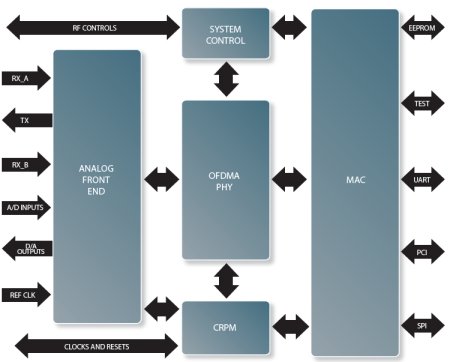Two Linux-based WiMax designs debut
Feb 7, 2008 — by Eric Brown — from the LinuxDevices Archive — 1 viewsFinnish wireless equipment integrator Elektrobit (EB) will showcase two new Linux-based, WiMax-connected product designs at GSMA in Barcelona next week. One is an Intel Menlow-based mobile internet device (MID) that uses virtualization to improve VoIP quality-of-service, while the other is a smaller handset that uses a NextWave WiMax chipset.
The larger-format MID device has yet to be formally announced, though an EB spokesperson confirmed that it will be Linux-based and support WiMax, WiFi, and Bluetooth networking. Interestingly, the device will use VirtualLogix's VLX technology to run VoIP functions in a separate environment from Linux, an architecture aimed at guaranteeing QoS (quality-of-service) for voice communications, the companies say. Presumably, the virtualization layer owns the hardware in the device, and can avail the VoIP software subsystem of privileged access to the WiMax interface when calls are in progress.
The MID device will be built around an Intel Menlow chipset, said the spokesperson. Aimed at the MID market, and still on target for shipment in the first half of this year, Menlow comprises Intel's “Silverthorne” mobile device processor and “Poulsbo” companion chip (integrated north-/south-bridge), along with an optional penny-sized Z-P140 solid-state disk that will scale to 16GB.
WiMax handset design
The reference design for the small NextWave-based handset was announced yesterday, with few details. The handset will offer carrier-grade VoIP and high-speed multimedia services, and is based on Trolltech's Qtopia-based VoIP phone stack.
EB claims its WiMax-connected handset will offer seamless operation and roaming across major global spectrum allocations, including 2.3 ~ 2.7GHz and 3.4 ~ 3.8GHz. The handset design will also support local variations such as the WCS (Wireless Communications Service) and EBS/BRS (Educational Broadband Service/Broadband Radio Service) bands in the U.S., says the company.

NextWave NW1100 architecture
(Click to enlarge)
The handset design is based on NextWave's ARM-9-based NW1100 WiMax baseband mobile subscriber SoC (system-on-chip), says EB. It also uses the NW1100's companion NW1200 chip, a multi-band RFIC (radio frequency integrated circuit).
Pushed by Intel, Sprint, Samsung, and others, WiMax provides fixed or mobile wireless broadband connectivity without the need for direct line-of-sight with a base station. According to a statement by the WiMax Forum, with a typical cell radius deployment of two to six miles, WiMax can deliver capacity of up to 40Mbps. At lower data rates, it can operate over distances as long as 30 miles.
In regard to the handset announcement, EB EVP Arto Pietili stated, “Through our collaboration, NextWave Wireless has successfully demonstrated VoIP calling over mobile WiMax in a handset form-factor. This project demonstrates EB's ability to turn next generation wireless technologies into enriching end-user experiences.”
Stated James Brailean, CEO, Mobile Products Division, NextWave Wireless, “With EB, we've addressed two critical issues for network operators: time-to-market and a differentiating handset solution.”
Availability
The NextWave Wireless/EB mobile WiMax reference design will be demonstrated by appointment-only at NextWave's stand (AV40) at the GSMA Mobile World Congress on February 11-14 in Barcelona. EB may be demonstrating both the handset and its mystery MID at the Finnish Pavilion, Stand Block 1F07. There was no information on pricing or availability of these designs.
This article was originally published on LinuxDevices.com and has been donated to the open source community by QuinStreet Inc. Please visit LinuxToday.com for up-to-date news and articles about Linux and open source.